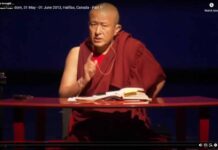
For centuries, for Westerners (from Marco Polo, to Alexandra David Neal, to Gurdjieff and Heinrich Harrer) Tibet was the land of magic and mystery, the place to get into; or a piece on the board of the Great Game—the Younghusband expedition in 1903-04, or the CIA’s covert operations in 1949-50. But by the mid-50s, with the ominous and growing presence of Chinese Communist troops, it was the place to get out of, fast, as both the Dalai Lama, His Holiness Dilgo Khyentse, Rinpoche and the Karmapa managed to do in less than a month’s time.
Not so for the just-turned-twenty year old young man in far eastern Tibet, whom the world would later come to know as the Vidyadhara.
Touch and Go is no Hollywood great escape movie with Steve McQueen jumping barbwire fences on a bike, but the strategically paced recreation of the journey Chögyam Trungpa Rinpoche chose to begin on the full moon day of April 1959, and through great luck and seconds to spare tight squeezes managed to finish eight months later when his party made their last dash across the Brahmaputra river in leather coracles (big cups, basically) under a rising December full moon with “bullets whizzing overhead”: As Rinpoche once cracked, this was “not Star Wars.”
Thanks to Flight Simulator fly-overs and panoramas above endless mountain ranges and Google Earth zooms, Touch and Go gives us a view we could never have had before of Rinpoche’s escape across the highest, coldest, snowiest, slipperiest, wettest ground on this planet, often necessarily at night, in frozen clothing, with only binoculars, intuition, and geomantic divination for life or death direction decision-making: all recounted in the director Grant MacLean’s calm, minimally eloquent voice-over using Rinpoche’s own words, maps and drawings from Born in Tibet.
Never refusing help to other escapees—their lines sometimes dangerously swelling to over 300; forbidding retaliation against the Chinese; at the very end reduced to eating leather stewed from their yakskin bags; Rinpoche himself sometimes feeling “at the end of his tether,” yet reverting to practice whenever a pause in the action occurred, always maintaining his sharp twinkle-in-the-eye sense of humor (which this movie could quote more freely from), but with the final decisions always falling to him: This online film is a topographically accurate, step-after-step revelation of the hardships the Vidyadhara, like his Kagyu forefathers, endured to get to us, his naïve and tenderfoot students with whom, as he said in his Introduction to The Rain of Wisdom, he then found himself “left out in the cold [again!] as full-time garbageman, janitor, diaper service and babysitter.”
By the time Touch and Go ends with the flight of a DC3 into India, one comes to feel a silent, eyes-wide-open awe at the snow range majesty of the Vidyadhara’s achievement. And an even deeper resonance, as in one long enduring gong echo, to his command: “Never give up.”
Followed by that soft-spoken admonition he’d often add to the end of an answered question: “You can do it, sweetheart.”
















